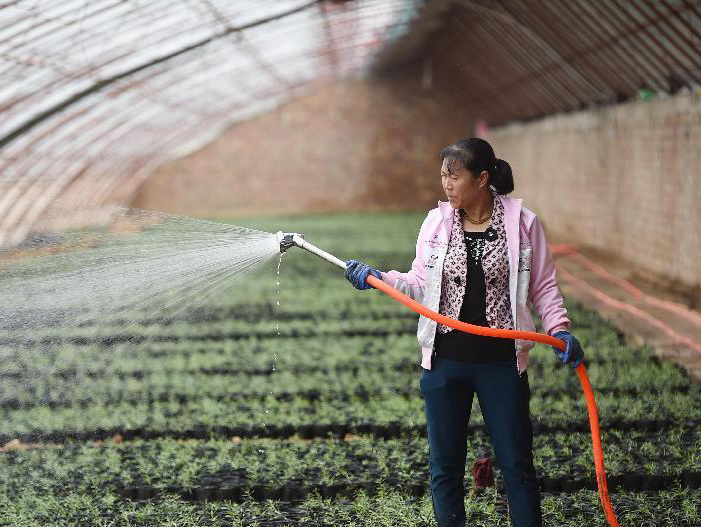Eradication of poverty needs targeted measures

A farmer waters her vegetables in a greenhouse at a village in Ningxia Hui Autonomous Region. In order to help some villagers step out of poverty, the local government has been supporting them to build photovoltaic vegetable bases for increasing their earnings.
With the reduction and decentralization of impoverished people, poverty relief in China has entered a key stage.
Chinese President Xi Jinping recently emphasized the necessity of putting more effort into targeted poverty relief during his tour of Guizhou Province.
Key step for society
Feng Kaiwen, a professor from the School of Economics and Management at China Agricultural University, said that the country’s previous standard was relatively low and many poor people were above the poverty line. Subsequently, the Chinese government raised the line, declaring that impoverished people are those who earn less than $2 per day, Feng added.
According to data from the National Bureau of Statistics in 2015, the number of impoverished people in China was 71.01 million in 2014, 12.32 million fewer than the previous year.
Wang Sangui, director of the Anti-poverty Research Center at Renmin University of China, said the achievements of creating a well-off society should be enjoyed by the impoverished. Lifting more than 70 million people out of poverty is a significant step in building a well-off society.
More comprehensive model
China has adopted various models of poverty alleviation, including material and development-oriented ones. All of these models have made achievements and accumulated valuable experience. Targeted poverty relief is another innovation of assisting the poor, which is based on previous experience and lessons.
“Since the mid-1980s, the model of development-oriented poverty relief has been implemented in rural areas, with the aim of realizing physical capital accumulation including infrastructure. The rural minimum living standard guarantee program was established in 2007, better supplementing the aforementioned model. Nowadays, as social development progresses, a more comprehensive model is needed,” Wang said.
In the long term, there are some obstacles to poverty alleviation. Wang said that there are two main reasons for the new model, including unfair income distribution and economic slowdown.
Zhang Junbiao, a professor from the College of Economics and Management at Huazhong Agricultural University in Wuhan, Hubei Province, said that there are fewer impoverished people in China, meaning that the model of poverty alleviation should address partial and individual problems due to their decentralization. “It is necessary for the government to build a new model that makes impoverished people truly enjoy related supportive policies,” Zhang noted.
Various measures
Some experts claimed that apart from the orientation of related polices, it is vital to take practical measures for realizing targeted poverty relief. Research of the real conditions of rural areas is needed to scientifically analyze all kinds of problems, explore more referential models, continuously accelerate poverty eradication and provide a solid foundation for building a well-off society, experts added.
Zhang said the object for poverty alleviation must be determined, with specific measures for specific regions.
Du Xiaoshan, a research fellow from the Rural Development Institute at the Chinese Academy of Social Sciences, said it is necessary to deal with the problem of poor policy implementation, build an interactive relationship between top design and grassroots innovation, prevent corruption in poverty alleviation, as well as getting the public, impoverished people themselves, media and third-party professional institutions involved.
Huo Wenqi and Pan Yuefei are reporters at the Chinese Social Sciences Today.

 PRINT
PRINT CLOSE
CLOSE